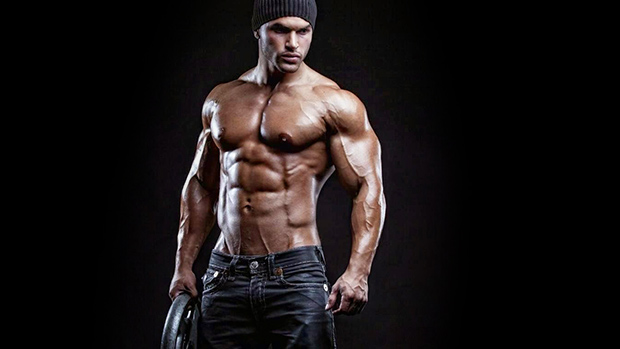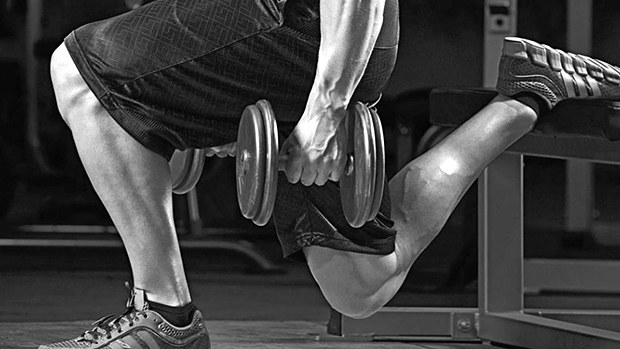How to Build Biceps – Really Stubborn Biceps!
The definition of insanity is doing the same thing over and over again and expecting a different result. So, if your biceps aren't growing, why aren't you adjusting your training? It's time to shatter training plateaus and start filling out your shirt sleeves.
Here's everything you need to know, six great exercises to try out, and a killer arm-day workout:
1. High Tension Training
Many lifters fail to build their biceps because, well, they're weaker than piss. If you want to grow, build a base of strength on compound movements like squats, deadlifts, bench presses, and, most specifically, rows and pull-ups.
The stronger you are, the more muscle fibers you can recruit and fatigue. You'll be able to lift heavier weights to create more progressive overload. You'll be able to lift lighter weights for more reps to create more metabolic stress.
If you're asking yourself, "Am I strong enough?" the answer is no. More strength will make achieving a physique-based goal more effective. The priority here is to emphasize building strength in the 4-8 rep range in major movements.
2. Metabolic Stress (The Pump)
When you get a pump, your muscles accumulate lactate, hydrogen ions, creatinine, and other metabolites while preventing blood from escaping the muscle. Most methods that emphasize metabolic stress create a mind-muscle connection and allow you to feel your biceps contract. This combination of training factors triggers muscle growth.
3. Muscular Damage
Muscular damage (in the form of soreness) shouldn't be the goal of training but rather an occasional byproduct.
Muscular damage itself isn't an indication you've had a great workout, but it will highlight that you've performed an exercise through a range of motion or created significant stress. The inflammatory response can trigger further growth.
4. Joint Friendly Training
Beat-up elbows are a death sentence for building big arms. Use various tools (rings, Fat Gripz, ropes) and hand positions (pronated, supinated, neutral grip) to prevent imbalances, mainly if training volume is high.
There are three main areas of focus:
1. Brachialis
Though typically considered a "forearm flexor," the brachialis lives underneath your biceps. By building it up, you'll create separation between your humerus and biceps and push your biceps up, resulting in bigger arms. Train the brachialis with a neutral hand position, like hammer curls.
2. Biceps Long Head
The long head of your biceps creates the biceps peak. Curl variations with a narrow grip and elbows at your sides or slightly behind your torso emphasize the long head. An example is incline dumbbell curls where your arms sit slightly behind your torso with a full stretch.
3. Biceps Short Head
The short head is best trained with your elbows in front of your body and with a wider grip. An example is a preacher curl where your elbows are clearly in front of your body.
1. Close-Grip Chin-Up, Accentuated Eccentric
Chin-ups are the upper-body squat. They create an immense amount of mechanical tension to activate and fatigue a ton of muscle mass. They'll add slabs of muscle to your lats, traps, rhomboids, forearms, and biceps.
- Use a slow, eccentric (negative) tempo of 3-5 seconds "down" on each rep.
- Use a grip approximately shoulder-width or slightly more narrow.
- If you can complete more than 10, add weight to drive faster gains.
- Incorporate rings and various grip tools to keep your elbows healthy.
- Do 4 sets of 5-8 reps with 90 seconds to two minutes of rest to kick-off a training session.
2. Pinwheel Curl
Pinwheel curls, also known as cross-body hammer curls, will demolish your brachialis. Compared to typical hammer curls, you can go heavier on pinwheels. There's a slight "cheat" when you cross your body that allows you to overload the eccentric aspect of the exercise for a better muscle-building stimulus.
Your brachialis tends to respond well to longer times under tension, reinforcing the importance of controlling the eccentric.
- Hold two dumbbells at your sides. You can go 5-10 pounds heavier on pinwheel curls than you would on hammer curls.
- Curl the weight across your body towards the opposite shoulder. Don't "cheat" the way up, but realize a little momentum towards the end may happen.
- Control the eccentric, lowering in 2-3 seconds.
- Do 3-4 sets of 8-10 reps per arm with 60-90 seconds of recovery.
3. Iso Dynamic Biceps Curl
This one incorporates an isometric contraction followed by a typical biceps curl. Isometrics help you recruit more motor units and help you improve your mind-muscle connection.
If you're struggling to grow your biceps but rarely feel them when training, this exercise should become a staple. You can also use this method with thick-grip curls and hammer curls.
- Sit on a bench and select a weight you can curl for 15 reps.
- Curl the weight to 90 degrees. Squeeze the dumbbells as hard as possible to create an irradiation stimulus and improve muscle fiber recruitment. Hold that squeeze for 15-30 seconds.
- After the hold, do 8-12 reps until you hit technical failure.
- Do 3 sets of 15-30 second holds. Do 8-12 reps with 60 seconds rest. Try doing this one twice per week.
4. Incline Dumbbell Curl with Mid-Set Stretch
These will leave you with a skin-splitting pump... if you can handle the pain. When you stretch a muscle, blood flow is restricted. It's the same when a muscle is contracting. With incline dumbbell curls, you begin in a fully-stretched position with your elbows behind your torso, which maximally recruits the long head. The training response amplifies even further with the mid-set stretch.
- Set an adjustable bench between 45-75 degrees. Hold dumbbells at your sides and keep your head back. Don't lean forward and take the stretch off your biceps.
- Use a set of dumbbells you can perform 15-20 curls with.
- Do 5 curls with a controlled eccentric tempo. After 5 reps, squeeze the dumbbells while allowing a full stretch at the bottom for 10-15 seconds. Now do 5 more reps. Repeat the stretch, perform 5 more reps, repeat the stretch.
- In total, you're aiming for 15 total reps with a 10-15 second stretch every 5 reps.
- Do 2-3 sets once per week as a finisher in your upper-body or arms workout.
5. Dumbbell Spider Curl
You can do spider curls in one of two ways: Lean over an incline bench, letting your arms hang straight down, or use the vertical side of a preacher curl. In both cases, spider curls keep your elbows to the front of your body and hammer the short head under maximum tension.
Because of the constant tension and elbow position, spider curls will create a ton of metabolic stress and help you improve the mind-muscle connection.
- Hold the dumbbell straight down in front of you and maintain a neutral spine. Don't round your shoulders and keel over like Gollum studying a recipe book on scalloped potatoes.
- Perform a controlled curl, holding and pausing with the dumbbell at your nose for 1-2 seconds.
- Do 3-4 sets of 8-10 reps with 45 seconds of rest.
6. Kettlebell Concentration Hammer Curl
These are incredibly taxing on your brachialis and most of the smaller muscles around your hands, wrists, and forearms. To stabilize the kettlebell, you'll need a crushing grip and a slow, controlled tempo. The kettlebell extends the arm position, which creates a lot more stress throughout the exercise.
- In a seated position, grab a lighter kettlebell and position your elbow against your inner thigh. You'll need to use about 50% of the weight you would for a dumbbell hammer curl.
- Squeeze the kettlebell as hard as possible and lock your wrist into place. Drive your elbow back into your leg and perform a curl with a 2-3 second concentric and 2-3 second concentric.
- Do 2 sets of 10-15 reps per arm towards the end of your workout.
You can either adapt your current workouts or substitute the exercises mentioned above. Or, take 4-6 weeks and add an extra day specifically focused on building your biceps. Try this full, arm-day workout:
- Accentuated Eccentric Chin-Up, 4×5-8, rest 2 minutes
- Dumbbell Pinwheel Curl, 3×8, rest 60 seconds
- Dumbbell Spider Curl, 3x10, rest 45 seconds
- Dumbbell Iso-Dynamic Biceps Curl, 3x15-30 seconds; 8-12 reps, rest 45-60 seconds
- Incline Dumbbell Curl with Intra-Set Stretch 3×15 (stretch 10-15 seconds every 5 reps), rest 45-60 seconds
- Kettlebell Concentration Hammer Curl, 2x10-15, rest 30 seconds
T Nation earns from qualifying purchases as an Amazon Associate. Read more about our policy.




